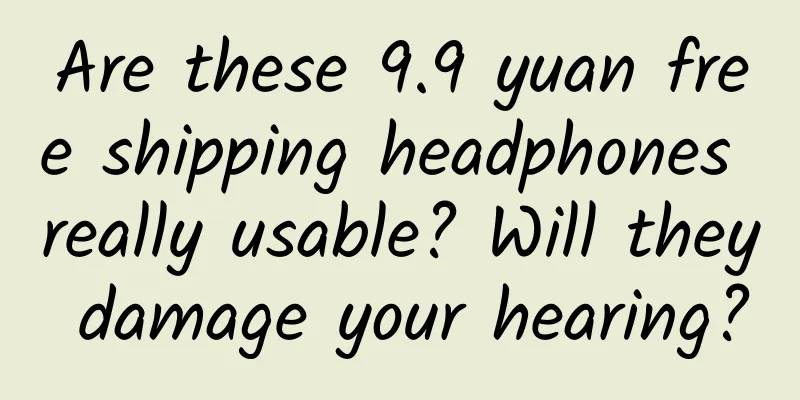Are these 9.9 yuan free shipping headphones really usable? Will they damage your hearing?

|
On many shopping apps, when you search for "headphones", you may find headphones with a wide range of prices, some costing hundreds or thousands of yuan, some costing 9.9 yuan with free shipping, and some even costing less than 2 yuan with free shipping. These prices can be said to be so cheap that they are a bit suspicious. Image source: Screenshot of an e-commerce platform If you search online, you can even find a lot of news about headphones leaking electricity. Are those headphones that cost a few dollars and include shipping really usable? Will using such headphones leak electricity? Will it hurt your ears? Let's talk about the relationship between headphones and hearing. Will cheap headphones leak electricity and hurt your ears? First of all, we need to distinguish here that the low price of headphones may be a promotional activity of the merchant, of course, it is also possible that the store sells headphones that do not meet quality standards. So how do we as consumers differentiate? In fact, it is very simple. Just check whether there is a "Quality Inspection Certificate" on or inside the packaging box of the earphones sent. According to Article 27 of the "Product Quality Law of the People's Republic of China" promulgated in July 2000, all products or their packaging should have a product quality inspection certificate. No matter how cheap the headphones sold in online stores are, they must have a product quality inspection certificate. If there is no certificate of conformity, then such products are probably not produced by regular manufacturers. If you really buy it, it is recommended not to use it to avoid leakage. And if you buy such a product, consumers can directly call 12315 or go to the official website of 12315 to protect their rights. As long as the headphones you buy have a product quality inspection certificate, you can usually use them with confidence. Of course, for headphones that cost 2 yuan free shipping or 9.9 yuan free shipping, don't have too high expectations for the sound quality. However, some people may find that even qualified headphones may have a slight "electric ear" feeling during use. This "electric ear" may not be caused by leakage of the headphones, but by static electricity generated by the friction between the headphones and clothes and hair. Apple's official website explains headphones and static electricity For example, Apple’s official website also has a special reminder about static electricity in headphones. You don’t need to worry too much about this mild "electric ears" phenomenon, and generally adding a sponge cover to the headphones can solve some static electricity problems. Compared with static electricity in headphones, when listening to music, excessive volume in headphones is more likely to damage hearing. Such damage is often more hidden and irreversible. Volume and hearing loss To understand how loud volume can damage the ears, we need to first understand the structure of the ears. After the sound waves are transmitted to the inside of our ears, a structure called "hair cells" in the cochlea can sense these vibrations and convert them into nerve signals to the brain. After processing by the brain, we hear the sound. Schematic diagram of cochlear hair cells, source: NIH But these hair cells are relatively fragile. If the vibration is too strong, the hair cells may be damaged. For example, if a person hears a loud noise suddenly, he may temporarily lose his hearing or have a tinnitus, which takes a while to recover. If the noise is particularly loud, or if the person is exposed to loud noise for a long time, the hair cells may be permanently damaged or die. Another characteristic of hair cells is that they cannot regenerate after death, which means that the hearing loss caused by hair cell death is irreversible. In contrast, hair cells responsible for sensing high-frequency sounds are more susceptible to damage, so people generally lose their hearing to high-frequency sounds first, such as the very sharp "sizzling" sound produced when microwave ovens and induction cookers are working, or the "sizzling" sound made when old transistor TVs and monitors are turned on. However, these sounds have almost no impact on daily life, so in the early stages of hearing loss, it is often difficult for people to notice it, and it is even more difficult to realize that their ear habits are unhealthy. How loud is it to hurt your ears? How loud a sound is before it damages hearing? This depends on the volume and the duration of exposure to that volume. The World Health Organization has given a safe listening time at different volume levels. Safe listening time and corresponding scenarios under different sound intensities. Image information source: WHO official website For example, the volume of our normal conversation is about 60 decibels. As long as we do not exceed this volume, the safe listening time per week is unlimited, which means that our hearing will not be damaged. When taking the bus or subway, the noise inside the car is about 85 decibels, and the exposure time per week is less than 12.5 hours, which averages out to about 1 hour and 40 minutes per day. But be aware that after getting on the subway or bus, you may unconsciously turn up the volume. This is because if you want to hear the sound in the headphones more clearly, the sound in the headphones must be higher than the volume of the background noise. The specific amount of increase varies from person to person. We can refer to a study published in Adv Exp Med Biol. in 2016, which found that people can understand semantics more clearly when the volume of a person's voice is more than 6 decibels higher than the background noise. So if we want to have a voice chat with someone on a bus with a background noise of 85 decibels, or want to hear the details in the music clearly, we can easily turn up the volume to 90 decibels or even above 95 decibels. Another study published in the International Journal of Audiology found that when the background noise was 75 decibels, people would already turn up the volume of their headphones to 90 to 95 decibels. Background noise and the sound intensity people tend to use. Image source: Reference [3] At 95 decibels, the safe listening time is 1 hour and 15 minutes per week, which is about 10 minutes per day on average. Most people's commutes are much longer than this. Therefore, listening to music on the bus or subway during commuting is likely to exceed the "safe listening time". In addition, an article published in Noise Health in 2017 studied the listening habits of young people in Sweden. About 10% of young people listen to music at too loud a volume, reaching 90 to 100 decibels. They even listen to music at such a loud volume when they sleep. This will undoubtedly damage your hearing. Copyright images in the gallery. Reprinting and using them may lead to copyright disputes. How to protect our ears? Based on what has been said before, protecting your hearing is actually very simple. Just pay attention to controlling the volume of the earphones when listening to music or making phone calls. But the question is, how do we know what volume we are listening to music at? In fact, many mobile phones have built-in hearing protection functions. When the volume is adjusted too high, a prompt will pop up automatically. At the same time, you can also directly adjust the safety upper limit, and automatically reduce the volume when the headphone volume exceeds the upper limit. Can be set to reduce extremely high sounds. Image source: provided by the author In addition, many mobile phones can also count the volume of headphones. For example, in the health module of Apple mobile phones, there is such a function, you can see what the volume of headphones is when you listen to music every day, and whether it exceeds the weekly "safe listening time". Headphone volume statistics. Image source: provided by the author In addition, if your phone does not have such a function, you can also refer to the World Health Organization's "60-60-60 principle", which means "the volume should not exceed 60% of the maximum volume, the single use of headphones should not exceed 60 minutes, and the surrounding volume should not exceed 60 decibels." If you want to enjoy your own music time while commuting, you can also consider using active noise-cancelling headphones. Most earbuds and in-ear headphones are passive noise-cancelling headphones, which means that they block external noise by plugging the headphones into the ears, but the blocking effect is relatively limited. Active noise reduction is when the headphones actively emit sound waves in the opposite direction of the sound waves to reduce the surrounding noise. The noise reduction effect of this type of headphones is often better, allowing you to hear music clearly at a lower volume. Of course, the disadvantage of active noise reduction headphones is also obvious, that is, they are relatively expensive. For headphones that cost 9.9 yuan and include shipping, it is unlikely to have such a function . And when using active noise reduction headphones, you must distinguish between occasions. When walking on the road or riding a bicycle, try not to use active noise reduction headphones, otherwise you may not be able to hear the horns of surrounding cars clearly, which may lead to danger. After all, hearing and driving safety are important! References [1] World Health Organization official website: https://www.who.int/en/news-room/questions-and-answers/item/deafness-and-hearing-loss-safe-listening [2] Whitmer, WM, McShefferty, D., & Akeroyd, MA (2016). On Detectable and Meaningful Speech-Intelligibility Benefits. Advances in experimental medicine and biology, 894, 447–455. https://doi.org/10.1007/978-3-319-25474-6_47 [3] Jiang W, Zhao F, Guderley N, Manchaiah V. Daily music exposure dose and hearing problems using personal listening devices in adolescents and young adults: A systematic review. Int J Audiol. 2016;55(4):197-205. doi: 10.3109/14992027.2015.1122237. Epub 2016 Jan 15. PMID: 26768911. [4] Widen SE, Båsjö S, Möller C, Kähäri K. Headphone listening habits and hearing thresholds in swedish adolescents. Noise Health. 2017 May-Jun;19(88):125-132. doi: 10.4103/nah.NAH_65_16. PMID: 28615542; PMCID: PMC5501022. Planning and production Author: Xiaowei Popular Science Creator Review | Pan Chunchen, deputy chief physician of Otolaryngology and Head and Neck Surgery, The First Affiliated Hospital of University of Science and Technology of China Planning丨Zhong Yanping Editor: Zhong Yanping |
Recommend
Former senior operator of Xiaomi: After three years at Xiaomi, I summarized the four most important experiences in user operations
User operation is a very important part of the op...
iOS 14.5 official version is here: 13 new features updated, 12 bugs fixed
After nearly three months of continuous improveme...
6 steps to quickly get started with growth hacking
Growth hacking is not a new concept in China. How...
How does novel distribution make money? What are the promotion methods for novel distribution?
With the rapid development of self-media, everyon...
Porsche's alliance with SAIC may help resolve the crisis
According to the latest information from the Secu...
To attract traffic to your product, you need to master the three "relative truths" of traffic promotion
Generating traffic is essentially about generatin...
99% of brand promotions are just scams?
What brands should do is to open the "door&q...
How to make a good online event promotion plan?
In marketing psychology, herd mentality, greed fo...
Startups need to clarify these 6 issues before they can carry out data-driven operations!
The era of "traffic is king" is over, a...
Why do some people get diarrhea after drinking milk? It turns out that this is the "trouble"
Many people have had this experience: bloating or...
Has the Changsha epidemic been lifted in 2022? When will things return to normal? Attached is the latest news!
In recent times, Hunan has achieved remarkable res...
Price inquiry for customized Qiannan beauty mini program. How much does customized Qiannan beauty mini program cost?
In order to better penetrate into various industr...
Guangzhou Sleep Mini Program Function, How much does it cost to develop a sleep monitoring mini program?
Nowadays, due to increasing stress on people, the ...
New plant species discovered in Medog, Tibet!
Recently, researchers discovered a new species of...
Google blocked 780 million low-quality ads last year
Friends who are familiar with Google know that th...









